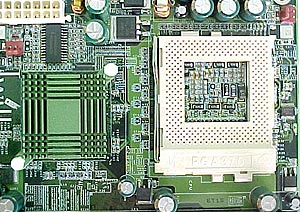The layout of the BD133 is fairly standard with the exception of one component. Of
all the components Iwill's motherboard designers decided to switch around, they picked what arguably has
to be the poorest location to move the floppy drive connector.

For whatever the reasons were, locating the floppy drive connector
at the base of the motherboard causes all sorts of issues - at least it did
for us. First off, since the connector is right at the bottom the floppy
connector has to wrap all around the PCI and AGP cards - potentially causing
issues with obstructed airflow.
But that doesn't even begin to compare to the fun you would
have if this board were mounted in a full tower case (like the HX08) that has
the floppy drive located at the very top of the case.
It seems there were a few other components on the BD133 that found their way
into less than ideal locations on the PCB. Granted some issues are trivial, but
others can be just a bit annoying over time.
 |
The ATX power connector is located directly behind the multimedia
ports making it accessible while at the same time potentially draping
power cables over-top of the processor fan. Note also how tight the fan
headers are situated. |
For instance, the ATX power connector is positioned just
behind the multimedia ports next to the AGP video card. While this does
make it very accessible, purists might argue that the large mass of power
cables could impede airflow the processor if the wires
weren't carefully tucked out of the way. Personally I wouldn't worry too much
about this, but I would take the time to twist-tie the ATX power cables to the
case to remove any possibilities of it getting in the way.
The AGP card is located
rather tight to the edge of the RAM slots so really have to remove it if you are going
to add or replace memory in the first two sockets. And last but not least, there isn't
even a hint of thermal material between the i815EP chipset and the little green BGA
cooler.
 |
 |
| Northbridge |
Southbridge |
Clear space around the processor socket is kept to a minimum on
three of the four sides. With clearance sitting at no more than 7mm on
each of those three side, you will have to shop conservatively when you
consider a heatsink for the BD133. Installation of the larger more exotic
heatsink's might not be possible due to the tight fit, however I didn't
have any problem installing my GlobalWin FOP-38, WBK-38 or ThermoEngine on
it.

On the plus side, the board itself measures a very tiny 19cm
x 30.4cm. It's a nice change from the larger boards like the Asus
A7V133 or Iwill KK266-R - I don't think you would have a hard time fitting this
motherboard in any sized case.
 |
| I had to remove video card to install memory since things were so tight. |
Even though I tested this board with someone else's processor, I was interested to see if I could push it higher... which didn't pan out. The highest stable speed I could get with the 1.0GHz PIII on the BD133 was 1148 MHz (7.5 x 153 MHz).
Now this isn't really too bad for an Intel processor, but I'm pretty sure the limiting factor was the chip and not the motherboard. If I had a cC0 or cD0 600E or 700E with good cooling I'm positive I could have gotten higher. True to form, Iwill's reputation for building extremely fast boards still holds :-)
Next up, the infamous Microstepping BIOS
utility....
